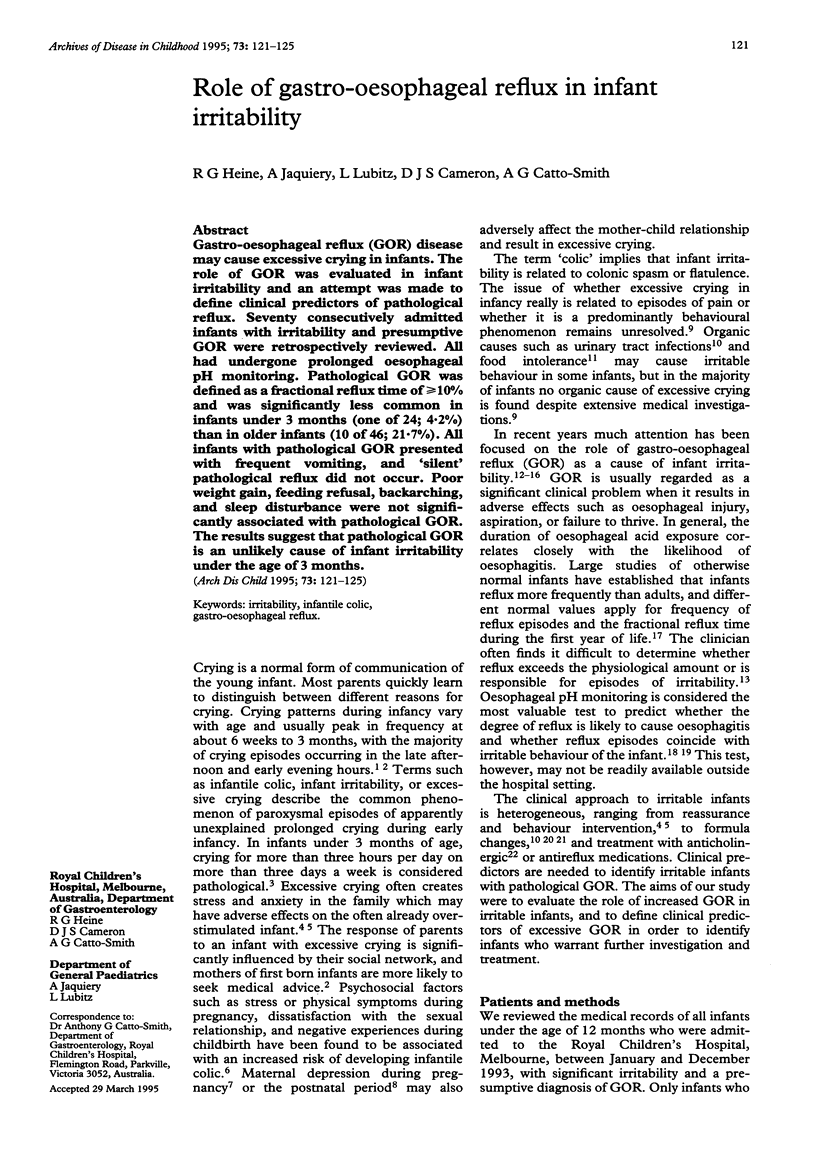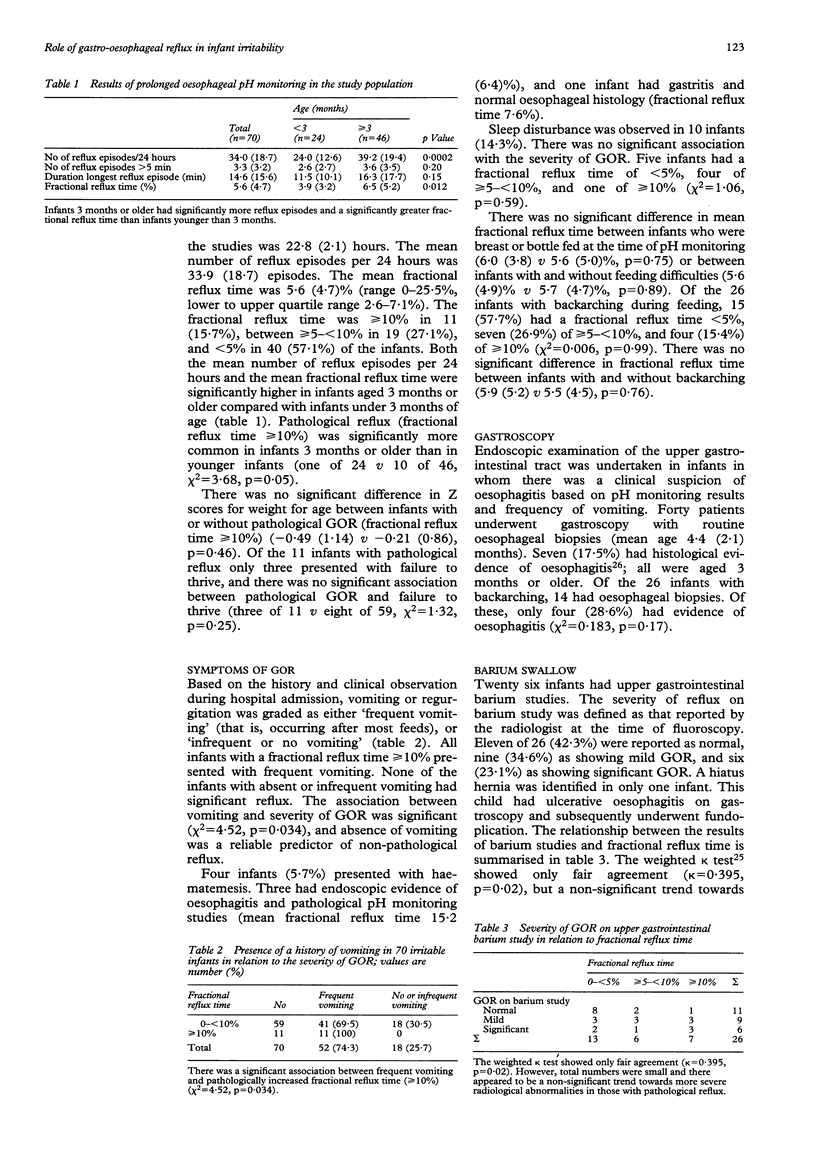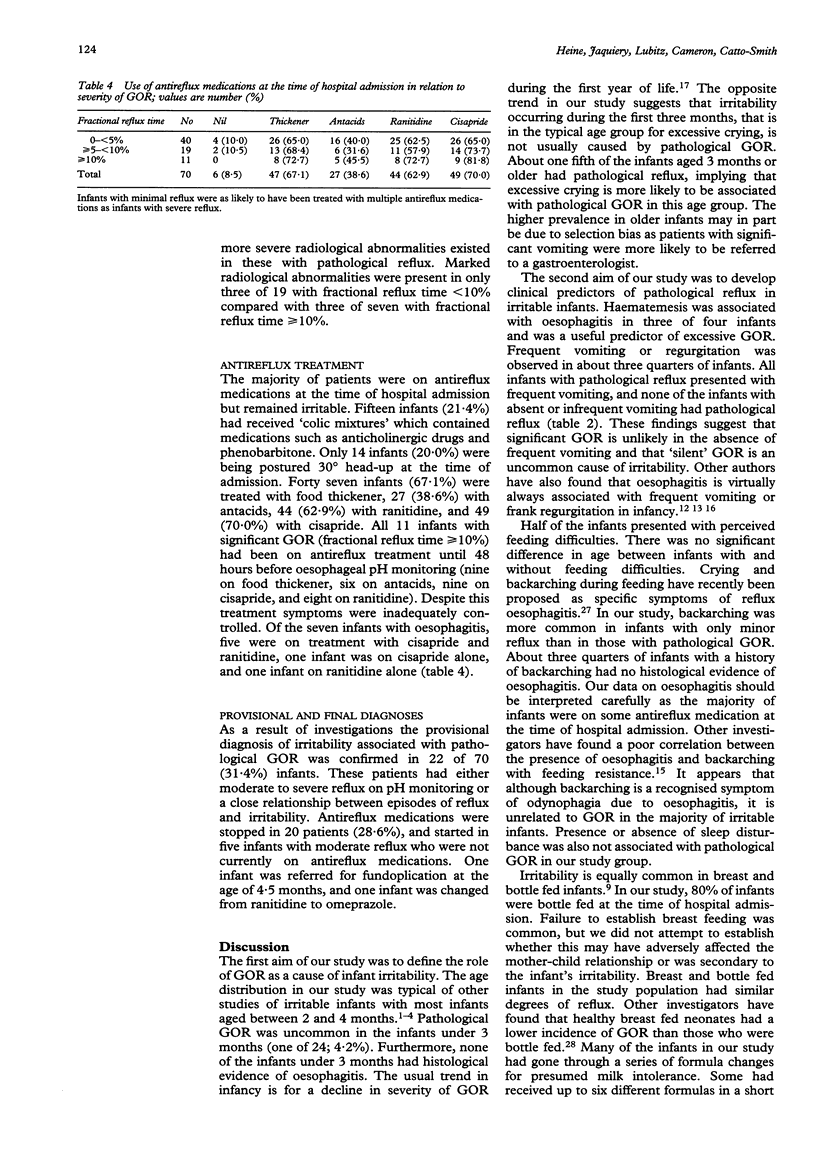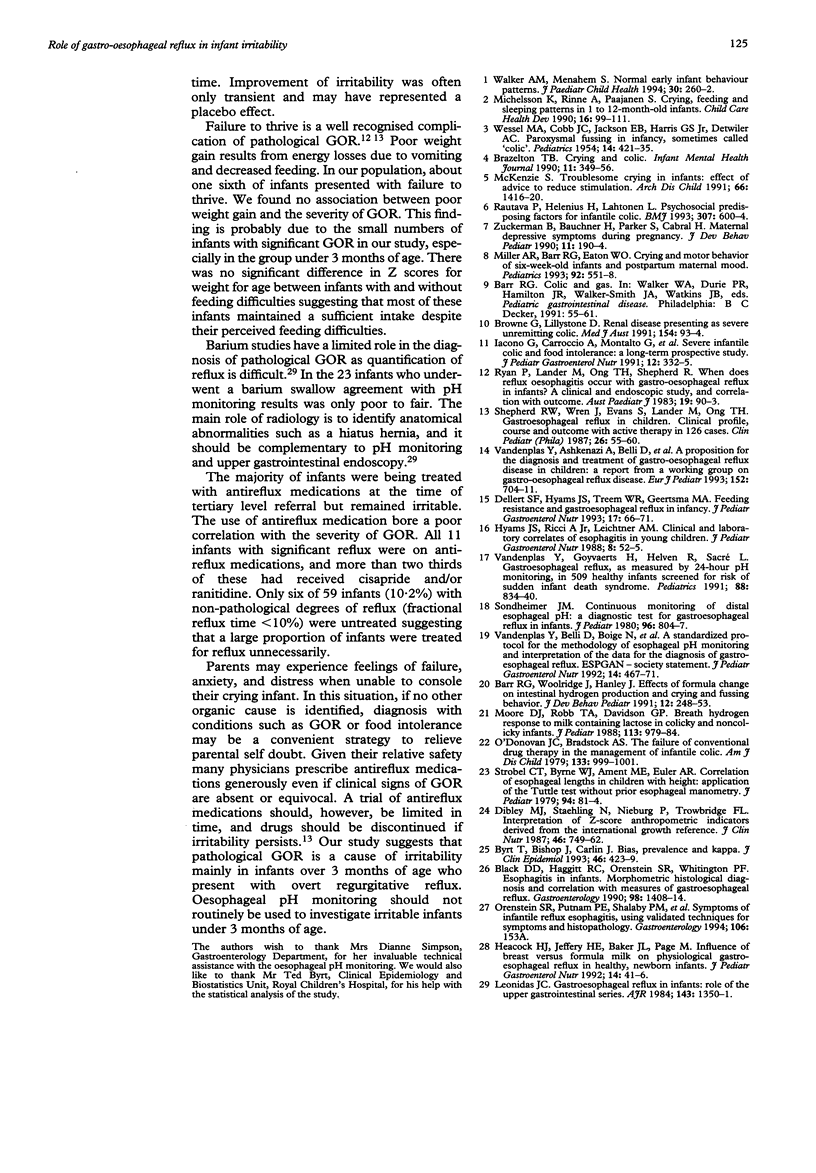Abstract
Gastro-oesophageal reflux (GOR) disease may cause excessive crying in infants. The role of GOR was evaluated in infant irritability and an attempt was made to define clinical predictors of pathological reflux. Seventy consecutively admitted infants with irritability and presumptive GOR were retrospectively reviewed. All had undergone prolonged oesophageal pH monitoring. Pathological GOR was defined as a fractional reflux time of > or = 10% and was significantly less common in infants under 3 months (one of 24; 4.2%) than in older infants (10 of 46; 21.7%). All infants with pathological GOR presented with frequent vomiting, and 'silent' pathological reflux did not occur. Poor weight gain, feeding refusal, backarching, and sleep disturbance were not significantly associated with pathological GOR. The results suggest that pathological GOR is an unlikely cause of infant irritability under the age of 3 months.
Full text
PDF




Selected References
These references are in PubMed. This may not be the complete list of references from this article.
- A standardized protocol for the methodology of esophageal pH monitoring and interpretation of the data for the diagnosis of gastroesophageal reflux. Working Group of the European Society of Pediatric Gastroenterology and Nutrition. J Pediatr Gastroenterol Nutr. 1992 May;14(4):467–471. doi: 10.1097/00005176-199205000-00017. [DOI] [PubMed] [Google Scholar]
- Black D. D., Haggitt R. C., Orenstein S. R., Whitington P. F. Esophagitis in infants. Morphometric histological diagnosis and correlation with measures of gastroesophageal reflux. Gastroenterology. 1990 Jun;98(6):1408–1414. [PubMed] [Google Scholar]
- Byrt T., Bishop J., Carlin J. B. Bias, prevalence and kappa. J Clin Epidemiol. 1993 May;46(5):423–429. doi: 10.1016/0895-4356(93)90018-v. [DOI] [PubMed] [Google Scholar]
- Dellert S. F., Hyams J. S., Treem W. R., Geertsma M. A. Feeding resistance and gastroesophageal reflux in infancy. J Pediatr Gastroenterol Nutr. 1993 Jul;17(1):66–71. doi: 10.1097/00005176-199307000-00009. [DOI] [PubMed] [Google Scholar]
- Dibley M. J., Staehling N., Nieburg P., Trowbridge F. L. Interpretation of Z-score anthropometric indicators derived from the international growth reference. Am J Clin Nutr. 1987 Nov;46(5):749–762. doi: 10.1093/ajcn/46.5.749. [DOI] [PubMed] [Google Scholar]
- Heacock H. J., Jeffery H. E., Baker J. L., Page M. Influence of breast versus formula milk on physiological gastroesophageal reflux in healthy, newborn infants. J Pediatr Gastroenterol Nutr. 1992 Jan;14(1):41–46. doi: 10.1097/00005176-199201000-00009. [DOI] [PubMed] [Google Scholar]
- Hyams J. S., Ricci A., Jr, Leichtner A. M. Clinical and laboratory correlates of esophagitis in young children. J Pediatr Gastroenterol Nutr. 1988 Jan-Feb;7(1):52–56. doi: 10.1097/00005176-198801000-00011. [DOI] [PubMed] [Google Scholar]
- Leonidas J. C. Gastroesophageal reflux in infants: role of the upper gastrointestinal series. AJR Am J Roentgenol. 1984 Dec;143(6):1350–1351. doi: 10.2214/ajr.143.6.1350. [DOI] [PubMed] [Google Scholar]
- McKenzie S. Troublesome crying in infants: effect of advice to reduce stimulation. Arch Dis Child. 1991 Dec;66(12):1416–1420. doi: 10.1136/adc.66.12.1416. [DOI] [PMC free article] [PubMed] [Google Scholar]
- Michelsson K., Rinne A., Paajanen S. Crying, feeding and sleeping patterns in 1 to 12-month-old infants. Child Care Health Dev. 1990 Mar-Apr;16(2):99–111. doi: 10.1111/j.1365-2214.1990.tb00642.x. [DOI] [PubMed] [Google Scholar]
- Miller A. R., Barr R. G., Eaton W. O. Crying and motor behavior of six-week-old infants and postpartum maternal mood. Pediatrics. 1993 Oct;92(4):551–558. [PubMed] [Google Scholar]
- Moore D. J., Robb T. A., Davidson G. P. Breath hydrogen response to milk containing lactose in colicky and noncolicky infants. J Pediatr. 1988 Dec;113(6):979–984. doi: 10.1016/s0022-3476(88)80567-5. [DOI] [PubMed] [Google Scholar]
- O'Donovan J. C., Bradstock A. S., Jr The failure of conventional drug therapy in the management of infantile colic. Am J Dis Child. 1979 Oct;133(10):999–1001. doi: 10.1001/archpedi.1979.02130100023003. [DOI] [PubMed] [Google Scholar]
- Rautava P., Helenius H., Lehtonen L. Psychosocial predisposing factors for infantile colic. BMJ. 1993 Sep 4;307(6904):600–604. doi: 10.1136/bmj.307.6904.600. [DOI] [PMC free article] [PubMed] [Google Scholar]
- Ryan P., Lander M., Ong T. H., Shepherd R. When does reflux oesophagitis occur with gastro-oesophageal reflux in infants? A clinical and endoscopic study, and correlation with outcome. Aust Paediatr J. 1983 Jun;19(2):90–93. doi: 10.1111/j.1440-1754.1983.tb02064.x. [DOI] [PubMed] [Google Scholar]
- Shepherd R. W., Wren J., Evans S., Lander M., Ong T. H. Gastroesophageal reflux in children. Clinical profile, course and outcome with active therapy in 126 cases. Clin Pediatr (Phila) 1987 Feb;26(2):55–60. doi: 10.1177/000992288702600201. [DOI] [PubMed] [Google Scholar]
- Sondheimer J. M. Continuous monitoring of distal esophageal pH: a diagnostic test for gastroesophageal reflux in infants. J Pediatr. 1980 May;96(5):804–807. doi: 10.1016/s0022-3476(80)80546-4. [DOI] [PubMed] [Google Scholar]
- Strobel C. T., Byrne W. J., Ament M. E., Euler A. R. Correlation of esophageal lengths in children with height: application to the Tuttle test without prior esophageal manometry. J Pediatr. 1979 Jan;94(1):81–84. doi: 10.1016/s0022-3476(79)80361-3. [DOI] [PubMed] [Google Scholar]
- Vandenplas Y., Ashkenazi A., Belli D., Boige N., Bouquet J., Cadranel S., Cezard J. P., Cucchiara S., Dupont C., Geboes K. A proposition for the diagnosis and treatment of gastro-oesophageal reflux disease in children: a report from a working group on gastro-oesophageal reflux disease. Working Group of the European Society of Paediatric Gastro-enterology and Nutrition (ESPGAN). Eur J Pediatr. 1993 Sep;152(9):704–711. doi: 10.1007/BF01953980. [DOI] [PubMed] [Google Scholar]
- Vandenplas Y., Goyvaerts H., Helven R., Sacre L. Gastroesophageal reflux, as measured by 24-hour pH monitoring, in 509 healthy infants screened for risk of sudden infant death syndrome. Pediatrics. 1991 Oct;88(4):834–840. [PubMed] [Google Scholar]
- WESSEL M. A., COBB J. C., JACKSON E. B., HARRIS G. S., Jr, DETWILER A. C. Paroxysmal fussing in infancy, sometimes called colic. Pediatrics. 1954 Nov;14(5):421–435. [PubMed] [Google Scholar]
- Walker A. M., Menahem S. Normal early infant behaviour patterns. J Paediatr Child Health. 1994 Jun;30(3):260–262. doi: 10.1111/j.1440-1754.1994.tb00630.x. [DOI] [PubMed] [Google Scholar]
- Zuckerman B., Bauchner H., Parker S., Cabral H. Maternal depressive symptoms during pregnancy, and newborn irritability. J Dev Behav Pediatr. 1990 Aug;11(4):190–194. [PubMed] [Google Scholar]


